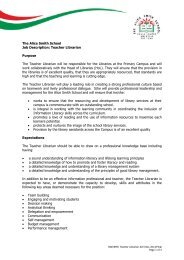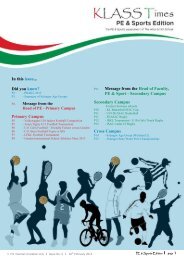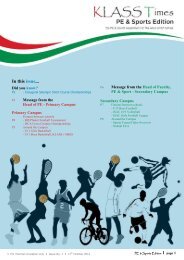Issue No. 006, 9th December 2011 - The Alice Smith School
Issue No. 006, 9th December 2011 - The Alice Smith School
Issue No. 006, 9th December 2011 - The Alice Smith School
You also want an ePaper? Increase the reach of your titles
YUMPU automatically turns print PDFs into web optimized ePapers that Google loves.
Use of Baseline Data at the Secondary Campus<br />
By Trevor Spence<br />
Assistant Principal - Development<br />
This is the third and final article on the use of baseline data. In the first article, I explained how the Computer<br />
Adaptive Baseline Tests were used to improve our understanding of your child's potential and learning needs. In<br />
the second article, I explained how such data provided us with a value added measure of the school's<br />
effectiveness. In this article, I will explain how this is all linked together in something we call - pupil tracking.<br />
Pupil tracking is an umbrella term for a range of activities that go on within the school that could equally be<br />
described as keeping an eye on your child's progress. It is a process in which tutors, teachers, departmental<br />
heads, assistant and key stage leaders, Assistant Principals and even the Principal are all engaged in at different<br />
levels. A tutor and teacher will, for example, keep an eye on each individual child's progress, department heads<br />
will track a class' progress, while assistant and key stage leaders will watch the progress of particular students<br />
who are causing us concern.<br />
At the core of pupil tracking is the establishment of targets for each child and establishing ways of measuring<br />
progress towards those targets. <strong>The</strong>se can be academic targets, but they can also be personal development<br />
targets. Here I am concerned with academic targets.<br />
At the start of each year, the teacher will set two targets for each child, the end of year target and the end of key<br />
stage target. <strong>The</strong> CABT provides a prediction that, alongside prior data, the expected rate of progression and the<br />
teacher's own judgement, is used to inform these targets. To this is added the KLASSfactor, ie. the expectation<br />
that every child has the capability of achieving their maximum potential at the <strong>Alice</strong> <strong>Smith</strong> <strong>School</strong> and therefore<br />
needs to be set a target which is ambitious but achievable. In simple terms, this means that the child's target will<br />
often be a full level or grade higher than the CABT prediction. At this point, we now have a starting point and an<br />
end goal set for each child.<br />
Before proceeding to explain what happens next, further explanation of the rate of progression is needed. As an<br />
example, let‟s consider the rate of progression at Key Stage 3, ie. from Year 7 to Year 9. Data from the UK shows<br />
us that the normal expected rate of progression is 2 levels over three years. As each NC Level is divided into<br />
three sub-levels, then this can be considered as 2 sub-levels a year. For example, a child may start on a 4c in<br />
English and therefore be reasonably expected to be at 4a by the end of Year 7, 5c by mid Year 8 and so on.<br />
What happens if we decide to be ambitious and aim for three levels of progression over the Key Stage? <strong>No</strong>w the<br />
child needs to make three sub-levels of progress in each academic year. In other words the same child from the<br />
example above would need to move from a 4c to a 5c by the end of Year 7. We now have a KLASS rate of<br />
progression that is ambitious and challenging, to both child and teacher.<br />
Of course a child's learning rarely moves in such a linear fashion. Rather there are plateaus where the child's level<br />
of understanding remains on the same level, followed by sudden bursts of progress as things begin to click, this<br />
can be further confused by dips as a child faces a new challenging task. This is why it is important to keep the<br />
long term goal in mind, not get upset about occasional setbacks as long as the overall picture is one of progress.<br />
So what happens next? Over a six week period, some teaching and learning goes on, a range of assessment<br />
methods are used to measure the child's progress and this progress is plotted against the child's target to see if<br />
the child is making the necessary progress. Every six weeks this tracking is reported to parents through the<br />
Progress Report. Where the child is making the right amount of progress, the teaching and learning can be<br />
considered effective and can move on confidently to the next challenge. Where the progress is so great that the<br />
child is leaping ahead then the learning is clearly working very well but the teaching may need to adapt to raise<br />
the level of challenge. As students can often excel in a specific part of the course, we wait to see a consistent<br />
pattern before raising the level of challenge by setting a higher target. Where the child is not making the<br />
expected progress, then the teaching and/or learning is not being effective for that child. <strong>The</strong> teacher looks at<br />
the individual learning styles of that child, considers the child's level of motivation and reflects on the teaching<br />
methods used in order to identify a way to address this issue. <strong>The</strong> teacher may, at this stage, look for parental<br />
support in tackling the issue, particularly where it is a case of motivation, but is more likely to be tackling this in<br />
class. Where a poor level of progress is being made concern is shared between the parent, the teacher and<br />
others, like the Head of Department and the tutor. Intervention strategies are planned and the child's progress is<br />
watched closely until things improve.<br />
Through such pupil tracking, we can ensure that each child is appropriately challenged and provided with the<br />
support necessary to help them overcome such challenges. Infused with an appropriate level of ambition it can<br />
help the child and teacher maximise potential and thus achieve the school's mission.<br />
For internal circulation only 9 th <strong>December</strong> <strong>2011</strong><br />
KLASS Times I page 13






